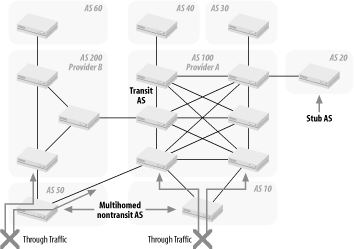BGP Extensions for IPv6
There is no actual BGP for IPv6. The IPv6 support derives from the capability of BGP-4 to exchange information about network layer protocols other than IPv4. These multiprotocol extensions of BGP-4 are defined in RFC 2858, which obsoletes RFC 2283. RFC 2283 is mentioned here because it is the base document for RFC 2545, which defines the IPv6 extensions of BGP-4. It is important to understand BGP-4 fully before looking at its multiprotocol extensions. The following sections start with a short overview of BGP-4 and its operations as defined in RFC 1771. BGP message types are then discussed. The last part covers the implementation of IPv6 information carried within BGP-4.
BGP-4 Overview
Each AS runs its interior routing protocol (RIP, OSPF, etc.) to distribute all routing information within the AS. The BGP is an exterior routing protocol whose primary function is to exchange information about the reachability of networks between ASes. Each AS receives a unique AS number assigned by the numbering authority. Figure 8-34 shows the different types of ASes that can be interconnected using BGP-4.

Figure 8-34. BGP traffic and AS types
The AS types are further explained in the following list:
- Transit AS
A transit AS has multiple connections to other AS. Routing updates from any AS arriving at the transit AS may be passed through the AS and distributed out to other ...
Get IPv6 Essentials now with the O’Reilly learning platform.
O’Reilly members experience books, live events, courses curated by job role, and more from O’Reilly and nearly 200 top publishers.

